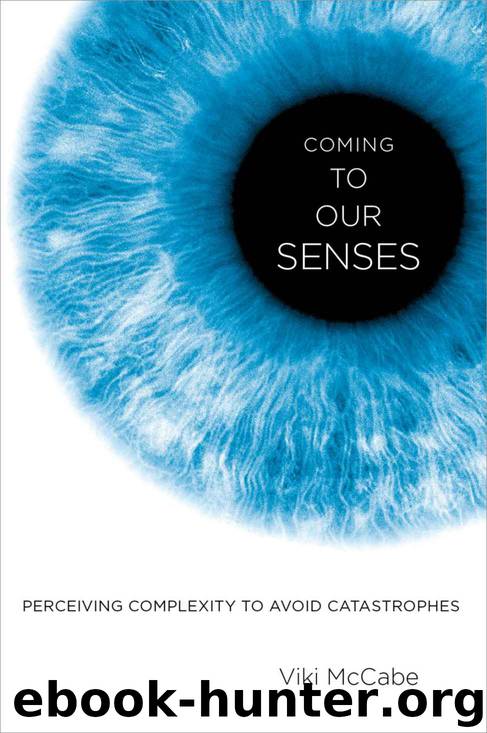Coming to Our Senses: Perceiving Complexity to Avoid Catastrophes by Viki McCabe

Author:Viki McCabe [McCabe, Viki]
Language: eng
Format: epub
Publisher: Oxford University Press, USA
Published: 2014-01-17T00:00:00+00:00
Reading the Seascape: Sea Gypsies Survive a Tsunami
It is not what is inside the head that is important. It is what the head is inside of.
—WILLIAM MACE
At almost 7:59 a.m. on December 26, 2004, the floor of the Indian Ocean shattered. As magma beneath the Earth’s crust expanded upward, the Indian tectonic plate slipped beneath the Eurasian Plate and triggered a 9.3 megathrust earthquake. If a satellite had tracked that event from beginning to end, it would have recorded the following sights: Approximately twelve hundred kilometers of the Sunda Trench ruptured, causing areas of the sea floor to rise by as much as eight meters. Hundreds of kilometers of seawater were displaced, creating a massive subsurface wave that ran unchecked toward the coastlines of Sumatra, Sri Lanka, Thailand, and Indonesia. When that tsunami made landfall, it topped a hundred feet, surged up to three miles inland, and swept away most everything in its path.
But most important, before the wave hit the shore, the long arm of the seismic system to which it belonged etched two unexpected and compelling visual signals into the seascape. First, it pulled the tide out far beyond the horizon, leaving the fish behind flopping about on the bare sand. Second, it simultaneously sent spiraling whirlpools to the surface of the Bay of Bengal. These two unusual visual signs should have put an attentive viewer on alert. Whirlpools are the signature patterns of turbulence—the chaotic motion of unruly waters that breach levees, sink ships, and at the very least signal that danger could be imminent. The tide presented an added threat. When such an enormous amount of water travels so far out, it accumulates enough potential energy to flood interior lands on its return. Both these visual signs signaled the danger at hand, and as if on a schedule, a killer tsunami made landfall.
Most people on the beach and the bay ignored, overlooked, or misunderstood the meaning of the tide and the visual messages of the whirlpools. In the end, 230,000 people perished. Yet one small indigenous group, the Moken Sea Gypsies, who live on their boats in the Andaman Sea, survived intact. As soon as they saw the tide recede and the whirlpools surface, and heard the cicadas fall silent, the Sea Gypsies ran to higher ground with the elephants. They even convinced a handful of tourists to come with them to the hills, and those tourists survived as well. The Moken on boats on the bay headed out to sea with the dolphins. Minutes later, the tsunami struck. The tourists and locals who ignored the receding waters and the rising whirlpools were swept away. Fishing folk who remained on their boats were catapulted into the water and dragged under as the wave came through.
Although the Moken have neither formal instruction nor personal experience with tsunamis, “they read nature’s signals,” says Jacques Ivanoff, an anthropologist with the Research Institute on Contemporary Southeast Asia who has lived with them for many years.34 During an interview, one Moken
Download
This site does not store any files on its server. We only index and link to content provided by other sites. Please contact the content providers to delete copyright contents if any and email us, we'll remove relevant links or contents immediately.
| Administration & Medicine Economics | Allied Health Professions |
| Basic Sciences | Dentistry |
| History | Medical Informatics |
| Medicine | Nursing |
| Pharmacology | Psychology |
| Research | Veterinary Medicine |
The Art of Thinking Clearly by Rolf Dobelli(10149)
The 5 Love Languages: The Secret to Love That Lasts by Gary Chapman(9523)
Mindhunter: Inside the FBI's Elite Serial Crime Unit by John E. Douglas & Mark Olshaker(9112)
Becoming Supernatural by Dr. Joe Dispenza(8045)
The Road Less Traveled by M. Scott Peck(7480)
Nudge - Improving Decisions about Health, Wealth, and Happiness by Thaler Sunstein(7469)
Mastermind: How to Think Like Sherlock Holmes by Maria Konnikova(7171)
Enlightenment Now: The Case for Reason, Science, Humanism, and Progress by Steven Pinker(7090)
Win Bigly by Scott Adams(7038)
The Way of Zen by Alan W. Watts(6459)
Factfulness: Ten Reasons We're Wrong About the World – and Why Things Are Better Than You Think by Hans Rosling(4635)
The State of Affairs by Esther Perel(4592)
Gerald's Game by Stephen King(4521)
Man's Search for Meaning by Viktor Frankl(4362)
The Confidence Code by Katty Kay(4166)
Thinking in Bets by Annie Duke(4127)
Hidden Persuasion: 33 psychological influence techniques in advertising by Marc Andrews & Matthijs van Leeuwen & Rick van Baaren(3421)
The Healing Self by Deepak Chopra(3412)
The Worm at the Core by Sheldon Solomon(3401)
